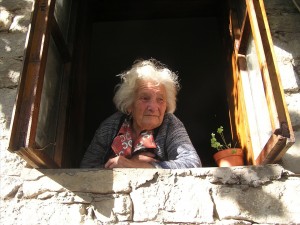“It’s my home,” Sylvia, 85, offers as a simple but profound explanation for why she’s not ready to give up her Manhattan apartment and move in with relatives. Though she lived with her own parents as they aged, Sylvia has lived alone for almost twenty years, since her husband passed away, as does her 92-year-old sister-in-law and many of her contemporaries in old age.

The advent of Social Security gave older people—and more often than not, older women—the financial resources to live on their own. Economists Kathleen McGarry and Robert Schoeni found that 59 percent of widows over the age of 65 lived with adult children in 1940, compared with 20 percent fifty years later. Today nearly a third of all older adults live alone. These rates rise with age and follow distinct gendered patterns, with women much more likely to live alone than men at all ages. By age 85, 47 percent of women and 27 percent of men lived alone in 2010.
Many older people struggle to make ends meet on Social Security as their sole source of income, or in combination with modest savings and pensions. For immigrant elders in cities like New York, living alone is often not an option due to a lack of affordable housing, linguistic hurdles, and cultural traditions of multi-generational living arrangements. While poverty rates rise with age and hit women hardest in late life, as my analysis of Census data has found, those who can afford to live alone usually do. Researchers expect that these trends will only increase with the aging of baby boomers, who have experienced higher rates of divorce, cohabitation, lifelong singlehood, and childlessness during their lifetimes.
Despite the financial, physical, and psycho-social challenges of living independently, many older people I’ve spoken to prefer to “age in place” and remain on their own for as long as possible, rebuffing numerous offers to move in with family. Why?
Classic sociological studies of community and family life found that a half century ago elders eschewed intergenerational living arrangements in favor of living independently. When British sociologist Peter Townsend interviewed older people in East London about their families in the 1950s, he discovered that most desired familial intimacy at a distance. They felt a deep attachment to their homes and didn’t want to invite conflict with adult children by moving in. They preferred to live near family instead of with family, and the great majority had a child living within a mile of them.
Despite the conventional wisdom and handwringing over the potential for isolation, sometimes living alone can be less isolating for older people than living with younger family members. As sociologist Arlie Hochschild found in her classic study The Unexpected Community, living independently among “age peers” can often provide greater opportunities for social interaction than within a family where an older person feels like a burden or “in the way,” as some of the older people I’ve spoken to have expressed. My own research on older adults aging in place has found that while many have loving, close relationships with their families and keep in touch by phone and email, co-residence poses a number of drawbacks. Eugene, a 90-year-old man living in New York I first met ten years ago, has received repeated offers to move in with his sister. They care deeply for each other. But even in the face of financial struggles and limited mobility that makes walking more than a city block physically draining, Eugene prefers to stay put rather than risk a loss of independence in the suburbs of Dallas: “I don’t drive, and they would have to take me everywhere.” Dispatches from siblings that have moved in with family provide him with little incentive. He reports that one younger sister has had a difficult time living with her son and wants to move into an assisted living facility where she can make friends and socialize. “Her son and daughter-in-law ignore her, and she’s miserable,” he cautions.
Older adults may also hesitate to move in with family due to expectations that they will provide unpaid care giving. Grandparents already provide significant help raising grandchildren, and low-income grandparent care givers can experience health declines and neglect their own preventative care when care work demands outstrip resources. In countries with a shortage of affordable child care, such as Japan, having a grandparent nearby can make it more difficult for families to obtain subsidized day care, due to assumptions that elder family members will provide care. Sociologist Jennifer Utrata’s study of Russian single mothers and grandmothers found that older women faced pressure to be good, self-sacrificing “babushkas” and to provide the lion’s share of unpaid care giving for their grandchildren and household help to their single daughters in the paid workforce.
Given demographic shifts toward an older, grayer society, it’s in everyone’s interest to invest in supporting elders so that they can age with dignity in their communities, whether living alone or with family, and understand that living alone does not guarantee isolation but in many cases can promote less stressful relationships between family members and the space to develop stronger bonds across generations.
Stacy Torres is a PhD candidate in sociology at New York University.

Comments